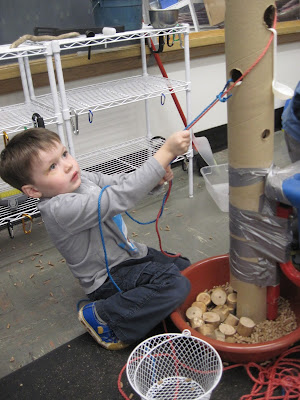Scott McCredie in his book Balance: In Search of the Lost Sense calls balance the sixth sense. For the most part, we take it for granted not realizing that it affects everything we do. It operates subconsciously in real time. Balance is a moving target, never static, because we are always moving and making complex but subtle adjustments to stay upright. Gill Connell and Cheryl McCarthy in their book A Moving Child is a Learning Child state: "It[balance] must be learned. And the only way to learn balance is through movement---all different kinds of movement experienced many times in many varied ways."(p. 84).
How can that happen in an early childhood classroom? I actually think it can and should happen all throughout an early childhood classroom. Instead of looking for examples throughout the room, however, I would like to examine different balancing strategies children employ at the sand and water table around just one apparatus. I could choose almost any apparatus I have built, but I will choose one of my favorites from 2013 I call tall cardboard tubes and ropes.
Below is another way to use the table to perform a more dynamic balancing operation. The child balances on the lip of the table on his abdomen.
He is able to do that because he bends his knees so his feet move toward the center of gravity closer to his abdominal balancing point. In addition, he grabs the lip of the table with his left hand for greater stability. This balancing operation allows him to reach further into the table to scoop pellets with his metal measuring cup.
In the photo below, the child in the lavender shirt is not leaning up against the table for balance. Rather, she leans over and into the table, but she extends her backside away from the table for counter balance.
Her balancing looks a bit strained. One reason for that is she grabs the lip of the bucket to help balance. However, the bucket hangs on the rope by a S hook so it sways with very little force. Is she steadying herself with her left hand at the same time she tries to steady the bucket?
Below is another nice bit of balancing by a child. This child is pouring pellets from his metal pot into the top of one of the cardboard tubes. To do that, he steps up onto the stool, stands on his tip toes, reaches up as high as he can and deposits the pellets into the top of the tube.
This child performs a little different type of balance. This balance is on a vertical with a fairly narrow base comprised of his tip toes. Besides the fact that he is doing an operation fully extended and over his head, this balancing requires the child to stay balanced as he hastily pours his pellets. He uses his left hand to grab a hole in the tube to steady himself, but that does not take away from the vertical nature of his balancing act.
In the photo below, the child is balancing using the thin ropes threaded through some of the holes in one of the cardboard tubes.
Here is one more example of a child performing a balancing act on the apparatus. The child stands on the thin lip of the table almost like a tight rope walker with her body straight and her arms out to the side. She even splays the fingers on her left hand to help her balance.
She does hold the top of the one of the tubes to aid in balancing, but the look on her face makes me think she is ready to let go of the tube to demonstrate her acrobatic balancing skills.
I have only given a few examples around one apparatus. Believe me, their are so many more. And with each new apparatus, the children find new ways to test their balance. I contend that if we look closely enough, the children are constantly finding ways throughout the classroom to challenge and fine tune their ability to balance physically, socially and psychologically . Just maybe being off balance is important for all learning---metaphorically speaking.































